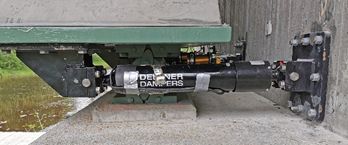Safety monitoring

Safety monitoring of railway bridge retrofitted with viscous dampers - Bothnia
Railway bridges are sometimes susceptible to dynamic excitation from passing trains, especially if the load frequency coincides with any of the natural frequencies of the bridge. For long and slender bridges on high-speed lines, this may occur within the range of the operational speed. In combination with low inherent damping of the bridge, excessive vibrations during train passage may pose both safety risks and riding comfort issues.
In this use case, a railway bridge located on the Bothnia Line in Sweden was retrofitted with viscous dampers to mitigate vibrations from passing trains. The bridge was inaugurated in 2000. The total structural length is 61.7 metres but the superstructure has a single theoretical span of 48 metres. The load bearing structure consists of a steel-concrete composite beam composed of two steel I-beams and a concrete deck.

A long-term monitoring system was installed in June 2021 comprising sensors for measuring acceleration, strain, temperature and displacement, as shown in the figures below. The sensors were connected to IoTBridge Monitoring System.
The system has a trigger that only saves data for passing trains. Each file is sampled with 150 Hz and contains 50 seconds of recorded data, including 10 seconds before the train enters the bridge. Since June 2021, the system has recorded more than 25,000 train passages. The figure below shows an example of the peak response from passages of the X62 train. The bridge has a natural frequency of about 2.6 Hz which in combination with the train centre bogie spacing of 16.4 m results in a resonance speed of 153 km/h. This fits well with the recorded results in Figure 2.

Based on the free vibration from passing trains, the modal properties of the bridge are constantly evaluated in real time by the IoTBridge algorithms and presented in the monitoring dashboard. In addition, the IoTBridge dashboard also presents the train speed and number of bogies, the bridge fatigue consumption and acceleration spectrum. Data analysis in the IoTBridge dashboard has revealed unique behaviour of the bridge with the following findings:
- The natural frequency of the bridge increases from about 2.6 Hz in summer to about 3.1 Hz in the winter as the ballasted track freezes. See Figure 3. This means that the stiffness of the bridge is about 40% higher in winter than in summer.
- The bridge dynamic properties and response is greatly affected by the vibration amplitude.
- The total damping of the bridge has increased by about a factor 2 since installing the viscous dampers, from about 1% to 2%.
The monitoring system will continue to run in order to study long-term effects of the dampers and the seasonal variations of the bridge behaviour

This work was carried out in collaboration with the bridge division at KTH Royal Institute of Technology. The project was financed by the European research program Shift2Rail and Trafikverket and serves as a demonstrator on how long-term monitoring can increase our understanding of bridge behaviour and that retrofitting with viscous dampers can be an efficient method of improving bridge dynamic performance.



